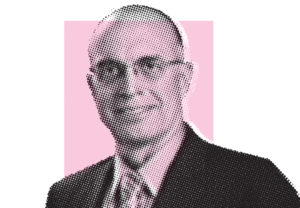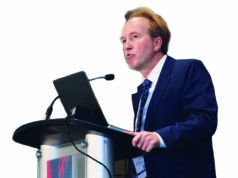
In 2019, Kim Hodgson, MD, kicked off his presidential year by placing appropriateness and quality of care under the microscope. His turn organizing the E. Stanley Crawford Critical Issues Forum at the 2019 Vascular Annual Meeting (VAM) saw the then incoming Society for Vascular Surgery (SVS) president tell the story of a cardiology and cardiac surgery team that had carried out hundreds of unnecessary procedures nearly 20 years ago.
A year later, he would tell this summer’s digital replacement for VAM: “Many thought that while it made a good story, it could not happen today.” Yet just a day later, VAM 2019 heard from Caitlin W. Hicks, MD, assistant professor of surgery at John Hopkins Medicine in Baltimore, about how new methodology had identified a significant number of physicians whose practice patterns might indicate failure to adhere to guidelines of care, Hodgson explained during the SVS ONLINE gathering for his State of the SVS address on June 20.
Further research from Hicks et al was to follow at SVS ONLINE on June 25, sharpening a core point of Hodgson’s address and appropriateness focus. They revealed a higher use of atherectomy during peripheral vascular interventions among non-vascular surgery specialists and physicians working primarily in outpatient settings. Together, the two talks, a year apart, neatly bookended his presidency.
Hodgson did not mince his words then. Neither was he sparing outliers eschewing “proper, guideline-directed care” in a recent interview as he looked back on an unprecedented presidential year interrupted by COVID-19. At SVS ONLINE, he said, the appropriateness lens was cast on atherectomy because Hicks’ research, subsequently presented at SVS ONLINE, had come to the attention of the Wall Street Journal (WSJ), which had asked the SVS to comment on what was an appropriate rate of use of atherectomy.
“While unable to answer that question specifically, we could look to our Vascular Quality Initiative (VQI) for insight, and the findings, presented in my State of the SVS address, were concerning,” Hodgson tells Vascular Specialist. I don’t want people to think I’m just hammering atherectomy, but the tremendous variation in use of atherectomy across physicians and the undeniable effect of site of service on utilization rates certainly raises the specter of inappropriateness. Having advance knowledge of what was going to be presented at SVS ONLINE on atherectomy and having analyzed VQI atherectomy utilization rates for the WSJ, I think it’s pretty obvious that we have an appropriateness problem with regards to atherectomy, undoubtedly encouraged by ill-conceived reimbursement policies.”
PRACTICE OUTLIERS
In the recent research, outpatient settings like office-based laboratories (OBLs) and ambulatory surgery centers have thrust to the fore as outliers. Yet, Hodgson is careful as he outlines realities on the ground.
“I think we need to be clear that we are not critical of OBLs themselves—a lot of great work is done by our members in this venue and the movement towards this site of service continues,” he says.
“But they’re also an environment that has very little oversight. I think we just have to acknowledge that. This lack of oversight has allowed those from specialties less well-versed in vascular disease, and perhaps appropriate indications for treatment thereof, as well as those with misaligned incentives, to jeopardize both patients and the integrity of our specialty itself. I also don’t want to portray this as a problem only because of cardiology, or only because of radiology. We have plenty of our own who are not following the guidelines. But clearly, the lack of oversight in the outpatient environment has enabled this.”
The ultimate goal is greater accountability, Hodgson goes on. “It’s not a perfect world. Even the verification program that we’re working on with the American College of Surgeons—which is an extension of our VQI—is a voluntary process at this point in time. Only the well-behaved are going to apply in the first place. But you have to start somewhere, and the goal is that we can set the standards through the verification program. This is something that is helpful to focus on a little bit: The verification program is going to set the standards for what is done and where it’s done for the treatment of vascular disease. For right now, it’s voluntary. But in the big picture, we believe that governmental agencies are looking for someone to do this for them. This may become linked in the future to payment. And that would be our ultimate win.”
The verification program forms one plank of Hodgson’s post-presidency focus.
SET APP
SVS ONLINE also saw the unveiling of the Society’s new Supervised Exercise Therapy (SVS SET) app, conceived and shepherded through development by Hodgson, with technological development by SVS member Oliver Aalami, MD, of Stanford University, California, and powered by telehealth company Cell-Ed.
The technology allows for home-based, doctor-prescribed exercise, which has been heralded as an advance on in-person SET as a first-line therapy to prevent surgical interventions and delay the progression of peripheral arterial disease (PAD). Hodgson is taking on a leading role as the Society seeks to move the app toward an eventual widespread rollout.
Right now, SVS SET is in clinical trials in order to determine its efficacy. In that vein, Hodgson revealed the SVS recently struck an agreement with health insurance giant Anthem to help fund the app’s clinical trial process.
“SET has gotten a tremendous amount of traction,” he explains. “We’ve signed a deal with Anthem to fund phase two and phase three of the app. And they’re very interested in seeing how our app can be incorporated into patient care in their healthcare system. That’s a pretty big deal.” Kenneth M. Slaw, PhD, SVS executive director, says the deal with Anthem led to tentative talks over a larger relationship involving potential collaboration on value-based care models.
A final note of pride for Hodgson is the passage of Society election bylaw changes, enfranchising, he says, “all SVS members to vote in our elections for the first time in the history of our Society,” which saw three-times more members vote in 2020 than in the Society’s highest previous year.
Meanwhile, as Hodgson considers the year as a whole, there isn’t a hint of wistfulness of what might have been. “COVID changed the way we approached some things—it may have slowed a few things down—but frankly I’m quite proud, and I think the SVS is quite proud, that we continued to move forward with a number of initiatives,” he says. Rather, what will endure are his proudest achievements: the ongoing quality initiative, the SVS Diversity, Equity and Inclusion Task Force he oversaw, and the bylaw changes, which came just as he was about to pass on the baton to Ronald L. Dalman, MD.












